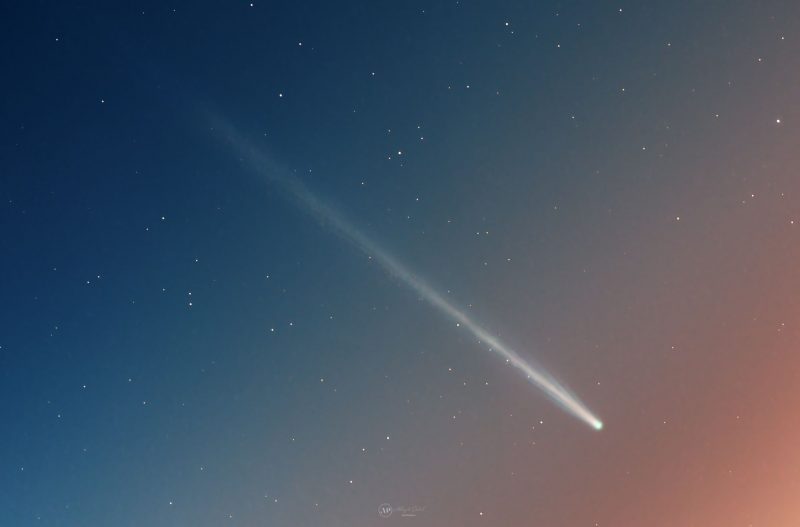
The 2024 lunar calendars are here! Best New Year’s gifts in the universe! Check ’em out here.
Top 10 stories of 2023
It was a busy year for astronomers, earth scientists and stargazers alike. From a new supernova and comet to the search for alien life, there’s been a lot to talk about! Next year promises to be even busier, with a total solar eclipse in North America and the sun heading toward solar maximum. Come along with us as we review our top 10 stories of 2023.
#1 – Comet Nishimura and the Sigma-Hydrid meteors
Comet C/2023 P1 (Nishimura) burst into our consciousness in August of 2023. It never got as bright as some hoped, but it still made a glorious target for astrophotographers. Comet Nishimura may also be the parent of a quiet meteor shower in December, the Sigma-Hydrids. Read more about comet Nishimura, and view a photo gallery.
#2 – Ivory-billed woodpecker isn’t extinct
The last “widely accepted” sighting of the ivory-billed woodpecker came in 1944. But there have been various reports of bird watchers spotting it over the years. The most recent report came in May 2023, when the National Aviary in Pittsburgh, Pennsylvania, provided “multiple lines of evidence”, including observations, trail cam footage and audio files, that the ivory-billed woodpecker persists. Read more about the ivory-billed woodpecker.
#3 – 200-foot asteroid 2023 DZ2 passed closer than the moon
On March 25, 2023, a newly discovered space rock safely swept past Earth. It passed by at about half the Earth-moon distance. Astronomers at the observatory of La Palma, in the Canary Islands, Spain, discovered the asteroid in late February 2023. Officials have ruled out future possible impact risks. Read more about asteroid 2023 DZ2.
#4 – Parachuting beavers created fire-resistant wetland
In the 1940s, Idaho officials rounded up beavers from populated areas and relocated them – sometimes by parachute – to remote areas such as Baugh Creek. Now, nearly 70 years later, NASA satellite images show that these areas where beavers settled are lusher, greener, and more resistant to fire and drought. Read more about parachuting beavers.

#5 – Sea-going search for alien fragments yielded odd spherules
This summer, Harvard astronomer Avi Loeb went on an expedition in the Pacific Ocean to search for remnants of an interstellar object that crashed there in 2014. While combing the ocean floor with what’s essentially a large magnet, Loeb reported that his team found tiny metallic spherules whose composition suggests an unearthly origin. Read more about the odd spherules.
#6 – New supernova! M101 explosion was closest in a decade
On May 19, amateur astronomer Koichi Itagaki discovered a new supernova in the Pinwheel galaxy, aka M101. It was the closest supernova to Earth in a decade. The supernova – named 2023ixf – lies in the direction of the constellation Ursa Major, near the end of the handle of the Big Dipper. See photos and learn more about the supernova in M101.
#7 – Was ‘Oumuamua a comet? Avi Loeb responds to new research
On March 22, EarthSky published a story – about a new peer-reviewed study conducted by researchers at UC-Berkeley and Cornell. The study suggested that the strange object known as ‘Oumuamua was simply a comet from another solar system. Meanwhile, for the past several years, Harvard astronomer Avi Loeb has been the most vocal scientist in putting forward theories that suggest ‘Oumuamua might be an alien spacecraft. Avi Loeb emailed EarthSky suggesting what he called a (non-peer-reviewed) “correction.” Here is Loeb’s response.
#8 – Asteroid 2023DW won’t hit Earth on Valentine’s Day 2046
On February 27, astronomers discovered a new asteroid that they labeled 2023DW. For a couple weeks, the asteroid was a one on the Torino scale as an object that was probably unlikely to hit Earth but still merited more attention. But as of March 16, astronomers have now determined that 2023DW will almost certainly not hit Earth on Valentine’s Day, February 14, 2046. Read more about asteroid 2023DW.
#9 – Lost tool bag from spacewalk caught on video
In November, astronauts conducting a spacewalk at the International Space Station accidentally lost a tool bag. The object floated off into space and was visible as a 6th-magnitude star. Some people even caught it on video. Read more and see the video of the lost tool bag.
#10 – Dragon bones on Mars? Curiosity spies weird rocks
On April 1(Sol 3786), NASA’s Curiosity rover came across some of the weirdest-looking rock formations yet. These rock slabs have rows of more or less equally spaced “spikes” sticking out of them. They kind of look like fossilized spines. In fact, some are playfully calling them dragon bones. Read more and see photos of the so-called dragon bones.
Bottom line: The top 10 stories of 2023 is a review of what we’ve learned in the past year from our home planet, Earth, and about our vast universe.